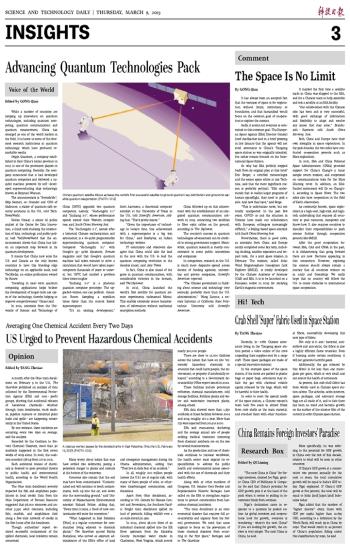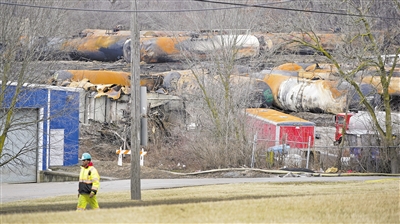
 |
| A cleanup worker passes by the derailed tanks in East Palestine, Ohio, the U.S., February 15, 2023. (PHOTO: VCG) |
A month after the Ohio train derailment on February 3 in the U.S., The Guardian published an analysis of data collected by the Environmental Protection Agency (EPA) and non -profit groups, showing that accidental releases of hazardous chemicals -whether through train derailments, truck crashes, pipeline ruptures or industrial plant leaks and spills - are happening consistently in the United States.
By one estimate, these incidents are occurring every two days on average, said the analysis.
Recorded by the Coalition to Prevent Chemical Disasters, more than 30 incidents happened in the first seven weeks of 2023 alone. In 2022, the coalition recorded 188 up from 177 in 2021.
Each accidental release of chemicals is deemed to pose potential threats to public health and environmental health, according to the World Health Organization.
The Ohio train derailment severely impacted the fish and amphibian populations in local creeks. Data from the Ohio Department of Natural Resource suggested that 38,000 minnows and another 5,550 adult creatures, including fish, crayfish, and amphibians died along a five-mile network of creeks in the first hours after the derailment.
Though authorities' report declared successful containment of the spilled chemicals, local residents remain concerned.
Many worry about toxins that may have settled into sediments, posing a persistent danger to plants and animals at the bottom of the waterway.
Concerns also remain that the soil may have been contaminated. "Contaminated soil will continue to leech contaminants, both up into the air, and down into the surrounding ground," said University of Massachusetts Environmental scientist Richard Peltier, adding that, "Every time it rains, a flood of new contaminants will enter the ecosystem."
"What happened in East Palestine[Ohio], is a regular occurrence for communities living adjacent to chemical plants," The Guardian quoted Mathy Stanislaus, who served as assistant administrator of the EPA's office of land and emergency management during the Obama administration, adding that "They live in daily fear of an accident."
In all, roughly 200 million people(across the U.S.) are at regular risk, with many of them people of color, or otherwise disadvantaged communities, said Stanislaus.
Apart from Ohio derailment, according to U.S. Centers for Disease Control and Prevention,the Southern Pacific freight train derailment spilled its load of pesticide, killing wildlife over a 40-mile stretch in 1991.
In 2014, about 38,000 liters of an industrial chemical spilled into the Elk River upstream from the Kanawha County municipal water intake in Charleston, West Virginia, which served nearly 300,000 people.
There are close to 12,000 facilities across the nation that have on site "extremely hazardous chemicals in amounts that could harm people, the environment, or property if accidentally released," according to a Government Accountability Office report issued in 2022.
These facilities include petroleum refineries, chemical manufacturers, cold storage facilities, fertilizer plants and water and wastewater treatment plants, among others.
EPA data showed more than 1,650 accidents at these facilities between 2004 and 2013, roughly 160 a year. More than 775 were reported from 2014 to 2020.
EPA said evacuations, sheltering and the average annual rate of people seeking medical treatment stemming from chemical accidents are on the rise by several measurements.
As the production and use of chemicals continues to increase worldwide, the health sector must expand its responsibilities to address the public health and environmental issues associated with the use of chemicals and their health effects.
Along with 47 other members of Congress, U.S. Senator Cory Booker and Representative Nanette Barragan have called on the EPA to strengthen regulations to protect communities from hazardous chemical accidents.
"The train derailment is an environmental disaster that requires full accountability and urgency from the federal government. We need that same urgency to focus on the prevention of these chemical disasters from occurring in the first place," Barragan said to The Guardian.


 Next
Next




